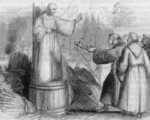
-
Monday Martyr – James Bainham

-
April 30 – Sir John Puckering

On this day in Tudor history, 30th April 1596, Elizabethan lawyer, administrator and Speaker of the House of Commons, Sir John Puckering, died from apoplexy, a stroke, at the age of fifty-two. He was buried at Westminster Abbey in St Paul’s Chapel.
[Read More...] -
29 April – William Dacre, 3rd Baron Gilsland, a lucky man

On this day in Tudor history, 29th April 1500, William Dacre, 3rd Baron Dacre of Gilsland and 7th Baron Greystoke was born.
Here are some facts about this Tudor baron:
[Read More...] -
April 28 – A priest is burnt in Scotland
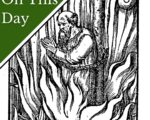
-
From the Archives – What did Tudor people sound like?

I’m often asked “what did Tudor people sound like?” so I thought I’d share some resources on this very topic from the Tudor Society archives.
[Read More...] -
April 27 – Can Henry VIII abandon Anne Boleyn?
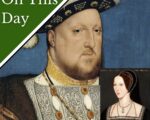
On this day in Tudor history, 27th April 1536, John Stokesley, Bishop of London, was approached to see if Henry VIII could “abandon” his second wife, Anne Boleyn.
Eustace Chapuys, the imperial ambassador, recorded that Stokesley replied that he would only give his opinion to the king himself, and that before doing so he needed to be clear what the king wanted. He certainly didn’t want to endanger himself by offending the king or the queen.
[Read More...] -
26 April – Catherine Carey, daughter of Mary Boleyn, marries Francis Knollys

On this day in Tudor history, 26th April 1540, in the reign of King Henry VIII, sixteen year-old Catherine Carey married Francis Knollys.
Catherine was the daughter of William Carey and Mary Boleyn, and the niece of Queen Anne Boleyn. Although some believe that she was Henry VIII’s daughter, there is no evidence for this.
Catherine served as a maid of honour to Anne of Cleves, and went into exile with her family in Mary I’s reign.
Catherine was appointed to her cousin Elizabeth I’s bedchamber in 1559. She served there until her death in 1569.
[Read More...] -
April 25 – St Mark’s Day

The 25th April is the feast of St Mark the Evangelist who was killed when he dragged by a horse until his head parted from his body.
In medieval and Tudor times, St Mark’s Day was the traditional day for praying for fertile land and a good harvest. People would process across fields carrying the cross, banners and bells to bless the crops and drive away evil spirits. It derived from the Roman pagan tradition of asking the gods for a good harvest.
[Read More...] -
Monday martyr – William Flower
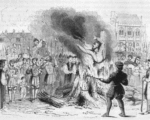
This week’s #mondaymartyr is Protestant martyr William Flower (known also as Branch) who was burnt at the stake at St Margaret’s Church in Westminster, London, on this day in Tudor history, 24th April 1555, in the reign of Queen Mary I.
Merchant-tailor and citizen of London Henry Machyn recorded in his diary that Flower, who was a former monk from the abbey of Ely, was taken to Westminster “and had his hand stricken off” before being burnt at the stake that had been set up in the churchyard.
[Read More...] -
April 24 – St Mark’s Eve and divination

24th April is St Mark’s Eve, a night that was all about maidens divining their future husband.
One way you can do this is to fast from sunset and then during the night bake a cake containing containing an eggshell full of salt, wheat meal, and barley meal. Once the cake is baked, you need to place it on the table to cool and open your front door. You then wait for a man to come in and turn the cake, he’s your future husband.
Here’s a video I did on St Mark’s Eve that goes into more detail:
[Read More...] -
April 23 – The Feast of St George

23rd April is the feast of St George, patron saint of England.
George, who famously saved a princess from a dragon, wasn’t always England’s patron saint. Until the 14th century, it was Edward the Confessor, and George didn’t officially take over until 1552, when all religious flags and banners, except for St George’s red cross, were abolished.
St George’s feast day was celebrated in Tudor England because this warrior saint had been important to the crusaders. His red cross on a white background had been adopted by the crusaders, eventually becoming England’s flag. The Order of the Garter was established under his banner in 1348 by Edward III and an annual chapter meeting always took place on 23rd April.
[Read More...] -
April 22 – Birth of Isabella I of Castile
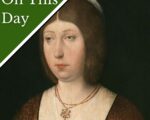
On this day in history, 22nd April 1451, Isabella I of Castile was born.
She may not have been English and her birth was not in the Tudor period, but she is linked to the Tudors because her daughter, Catalina de Aragón, or Catherine of Aragon, married Henry VII’s eldest son, Arthur, in 1501, and his second son, Henry, in 1509.
[Read More...] -
From the Archives: Talk on Henry VIII as a military leader
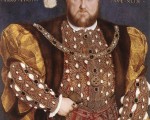
As today is the anniversary of King Henry VIII’s accession to the throne, I thought I’d share this talk by historian and author Gareth Russell on Henry VIII’s successes and failures as a military leader.
[Read More...] -
The difficulties of turning a short film about Henry VIII into a novel

This article is part of a blog tour for ‘I am Henry,’ the new novel based on the award-winning short film of Henry VIII and Anne Boleyn by Jan Hendrik Verstaten and Massimo Barbato, which is due out tomorrow, 22nd April.
We were delighted that our little short film ‘I am Henry’ was received well. It won, in total, 13 film awards, including a prestigious Gold Remi. The only criticism we had from the viewers that loved it was that it was not long enough. They wanted to see what happened to Henry VIII, Anne Boleyn and Catherine of Aragon.
[Read More...] -
April 21 – The death of Henry VII and the accession of 17-year-old Henry VIII

On this day in Tudor history, 21st April 1509 fifty-two-year-old Henry VII died, leaving the throne to his seventeen-year-old son, also called Henry.
Henry VII had ruled for over 23 years, since defeating King Richard III at the Battle of Bosworth in 1485.
The accession of Henry VIII, who was a good-looking and athletic young man of 6’3, was greeted with rejoicing. He seemed to be the ideal Renaissance Prince.
[Read More...] -
A hidden Tudor gem – Acton Court will be open to the public again soon!

Acton Court isn’t open all year around, but this year it will be open to the public from 31 May to 2 July 2023 with many special events happening in 2023
[Read More...] -
April 20 – The Oath of the Act of Succession
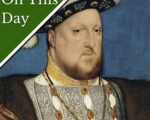
On this day in Tudor history, 20th April 1534, in the reign of King Henry VIII, prominent citizens of London were required to swear the Oath of the Act of Succession.
Chronicler Charles Wriothesley explained that all the guilds were called to their halls to swear:
To be true to Queen Anne (Anne Boleyn) and to recognise her as Henry VIII’s lawful wife and the rightful Queen of England.
[Read More...]
To think of the king’s eldest daughter Mary as illegitimate. -
April 19 – Bookseller James Duckett is hanged
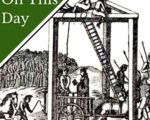
On this day in Tudor history, 19th April 1601, in the reign of Elizabeth I, bookseller James Duckett was hanged at Tyburn after being found guilty of felony for dealing in Catholic books. He was executed alongside the man who had informed on him, bookbinder Peter Bullock.
Duckett came from Westmorland and although he was named after his godfather James Leybourn, who was hanged, drawn and quartered at Lancaster in 1588 for denying Queen Elizabeth I’s supremacy, Duckette was brought up as a Protestant. However, he converted to Catholicism during his apprenticeship in London, when a man named Peter Mason gave him a copy of “The Foundation of the Catholic Religion”. His newfound zeal for Catholicism led to him being questioned and imprisoned for not attending Protestant services.
[Read More...] -
Hever Castle – still worth a visit? by Tim Ridgway

A few weeks ago, my father and I were able to get away for a morning to visit Hever Castle in Kent. It’s somewhere that you may have been to before, and it’s a castle that is very close to our hearts – we LOVE the way the grounds are kept and how the castle evokes the history of the Boleyn family, the time Anne of Cleves spent there AND, more recently, how the Astor family lived and renovated the whole area.
For a long time, Hever castle was quite static in its displays – not much changed, which was fine if you’d never visited before, but since we had visited so many times, it was rare to see anything new. That’s no longer the case.
[Read More...] -
April 18 – Thomas Cromwell becomes Earl of Essex

-
Monday martyr – John Hullier
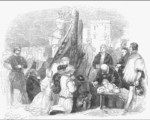
This week’s Monday martyr is Protestant martyr John Hullier (Hulliarde, Huller or Hullyer), who was burnt at the stake in Cambridge for his Protestant faith on Maundy Thursday 1556, 2nd April, in the reign of Queen Mary I.
Martyrologist John Foxe tells is that Hullier was educated at Eton before becoming a scholar and then a “conduct”, a chaplain, at King’s College, Cambridge, in 1539. Some time after that, he became curate of Babraham, near Cambridge, and had “divers conflicts with the papists” after preaching at King’s Lynn. This led to him being questioned by Dr Thomas Thirlby, Bishop of Ely, who sent him to be confined in Cambridge Castle and then the Tolbooth in Cambridge, where, according to Foxe, he was imprisoned for three months.
[Read More...] -
April 17 – A stolen head

On this day in Tudor history, 17th April 1554, celebrations led to a head being stolen!
The head belonged to Thomas Wyatt the Younger, leader of Wyatt’s Rebellion, who’d been executed on 11th April. It was never recovered.
The people of London were celebrating the acquittal of diplomat and politician Sir Nicholas Throckmorton, who’d been tried for treason for his involvement in Wyatt’s Rebellion against Mary I.
[Read More...] -
April 16 – The Mary Rose’s first tour of duty
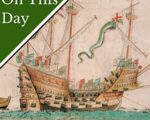
On this day in Tudor history, 16th April 1512, Henry VIII’s warship, The Mary Rose, began her first tour of duty in the English Channel on the hunt for French warships.
Here are some facts about The Mary Rose:
[Read More...] -
April 15 – Sir John Scudamore

On this day in history, 15th April 1623, Sir John Scudamore was buried at his home, Holme Lacy, following his death the previous day.
Scudamore served Elizabeth I as standard-bearer of the gentleman pensioners and his second wife, Mary Shelton, was related to the queen and was one of her ladies of the privy chamber.
Here are some facts about Sir John Scudamore:
[Read More...] -
From the archives – Henry VII: The Man

King Henry VII is often neglected in favour of his seemingly more interesting son, Henry VIII, or granddaughter, Elizabeth I, but he is a fascinating historical character.
In this week’s “from the archives”, historian Nathen Amin, author of The House of Beaufort and Henry VII and the Tudor Pretenders: Simnel, Warbeck, and Warwick, talks about Henry VII: the Man…
[Read More...] -
April 14 – Sir Anthony Kingston, Constable of the Tower of London

On this day in Tudor history, 14th April 1556, in the reign of Queen Mary I, former Constable of the Tower of London, Sir Anthony Kingston died at Cirencester.
Kingston was on his way to London to London to answer charges of treason when he died.
He’d been sent to the Tower for 2 weeks in December 1555 for “contemptuous behaviour and great disorder” in Parliament, but this time was more serious. He was accused of conspiring to rob the Exchequer for money to support Henry Dudley’s plot for an invasion of English exiles from France to topple Mary I and replace her with Elizabeth.
He was lucky to die a natural death, his fellow conspirators were executed.
[Read More...] -
April 13 – Anne Howard (née Dacre), Countess of Arundel and priest harbourer

On this day in history, 13th April 1630, seventy-three-year-old priest harbourer Anne Howard, Countess of Arundel, died at her home, the manor of Shifnal in Shropshire. She was laid to rest in the Fitzalan Chapel at Arundel Castle.
Here are some facts about this noblewoman…
[Read More...] -
Tudor music at its best with PIVA

-
April 12 – Anne Boleyn causes quite a stir
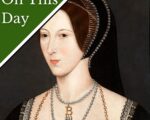
On this day in Tudor history, 12th April 1533, Anne Boleyn caused quite a stir by attending mass wearing cloth of gold and the richest jewels, and attended by sixty ladies.
Why the stir?
Well, because her marriage to Henry VIII was still a secret. The royal council had only just been informed.
[Read More...] -
April 11 – John Lumley, Baron Lumley

On this day in history, 11th April 1609, in the reign of King James I, conspirator, patron and collector, John Lumley, 1st Baron Lumley, died at his London home.
Lumley made a garden in honour of Elizabeth I, as an apology to her, and is known to have possessed a full-length portrait of Anne Boleyn.
Here are a few more facts about this Tudor baron…
[Read More...]
